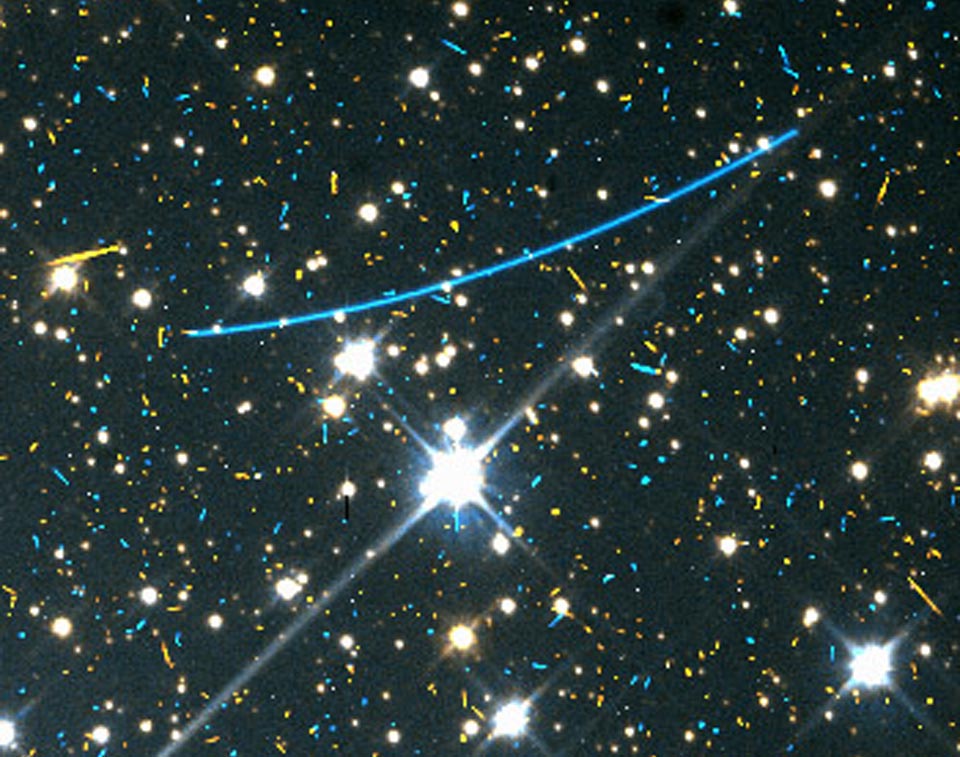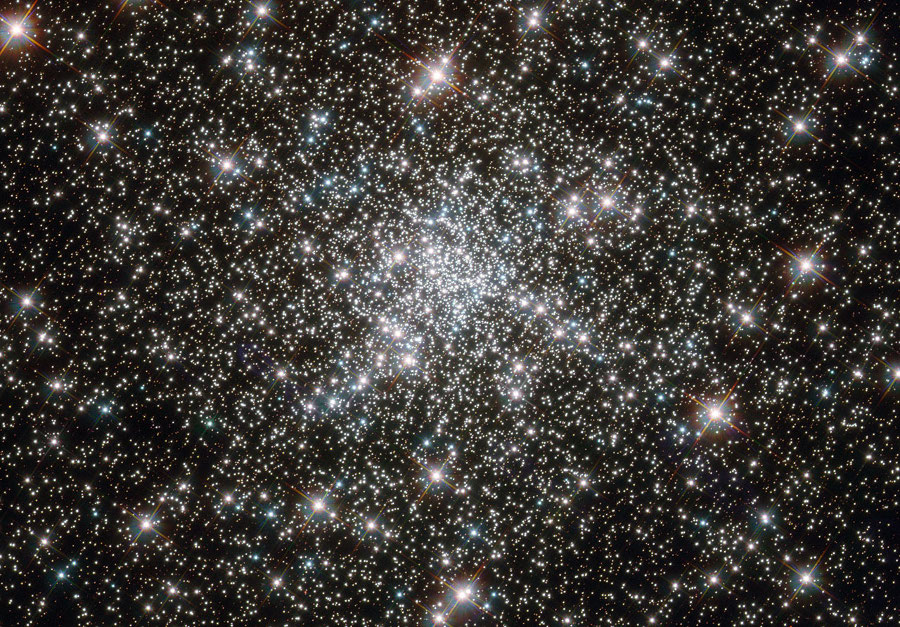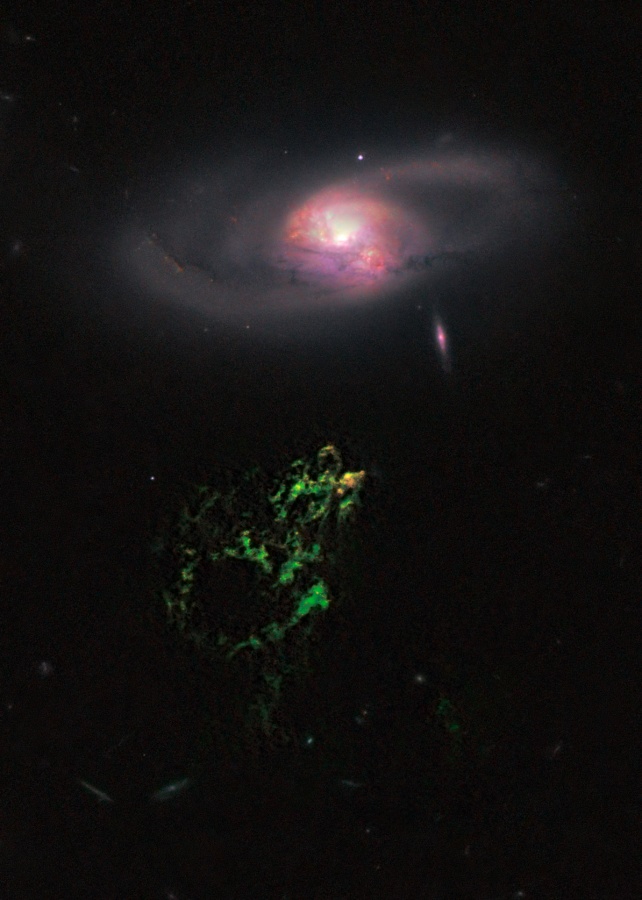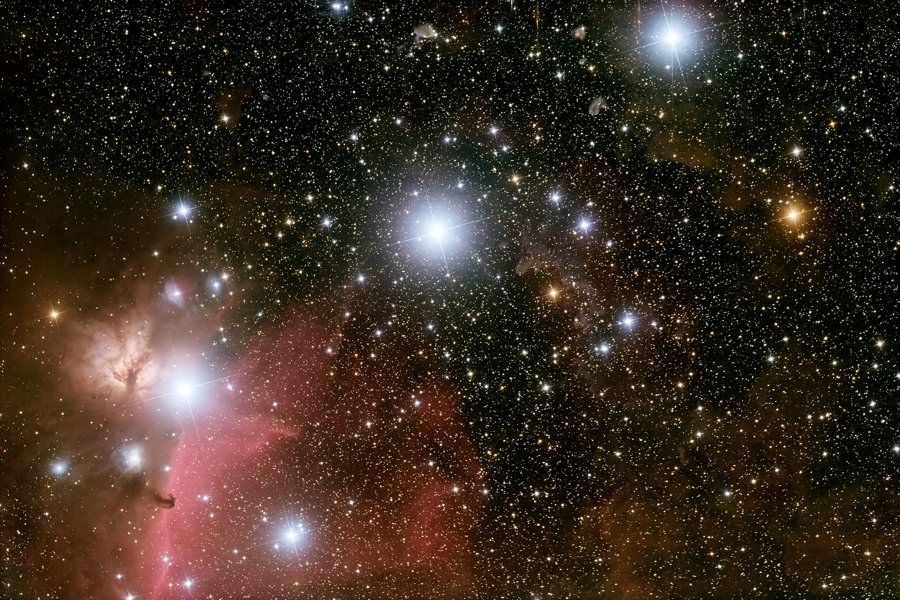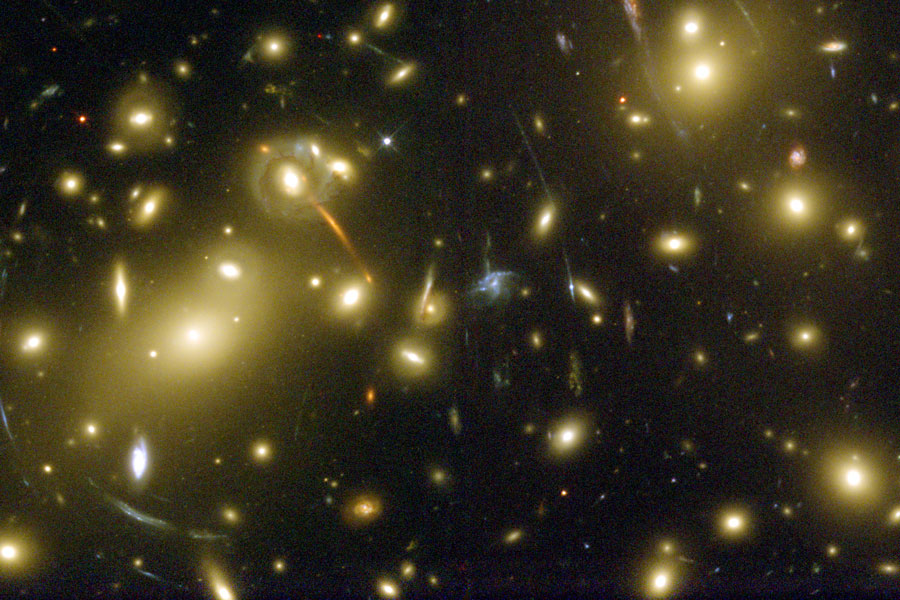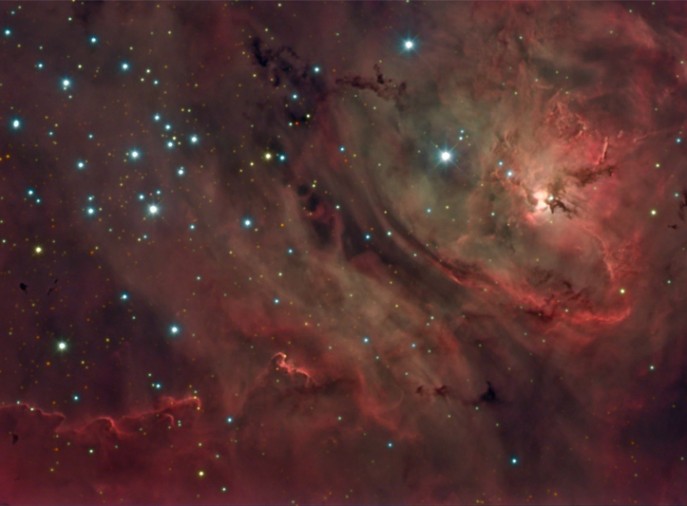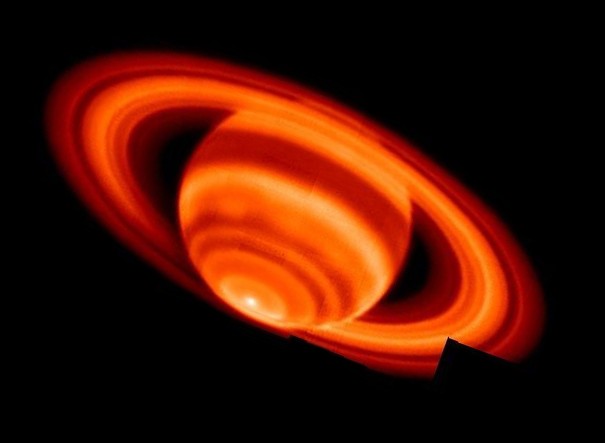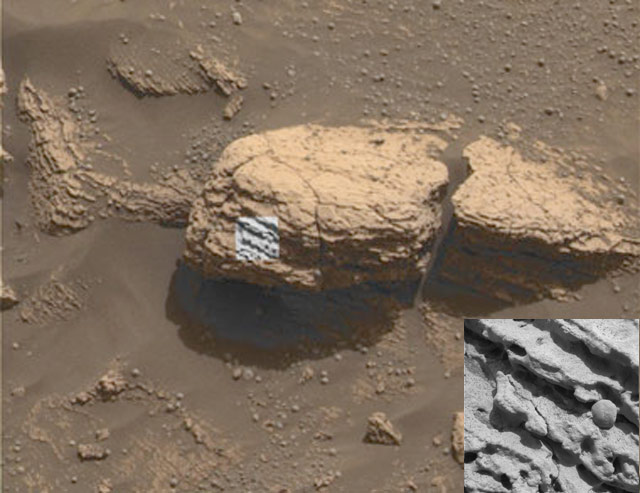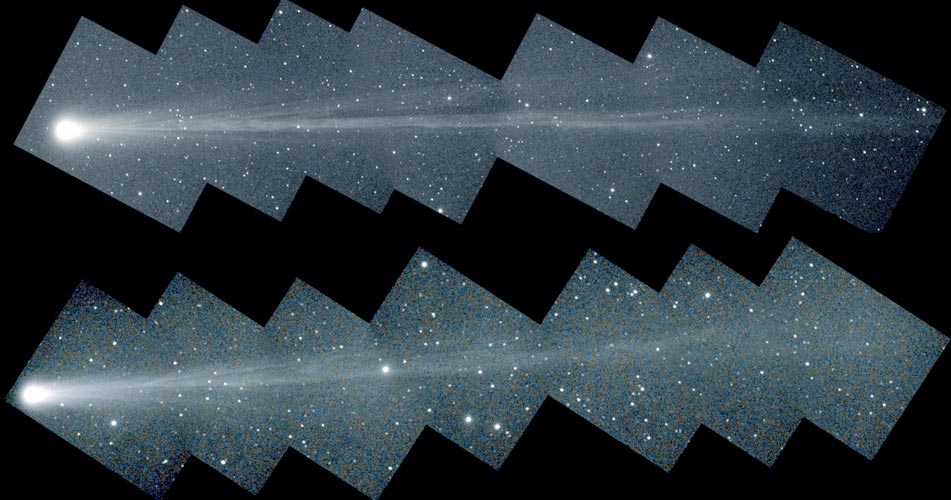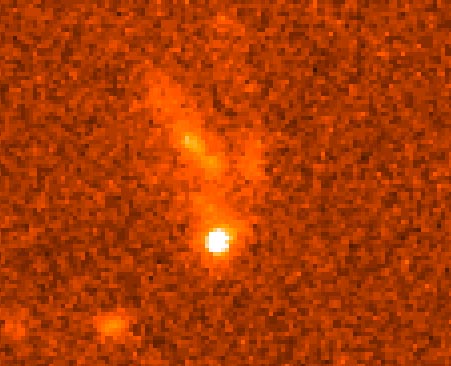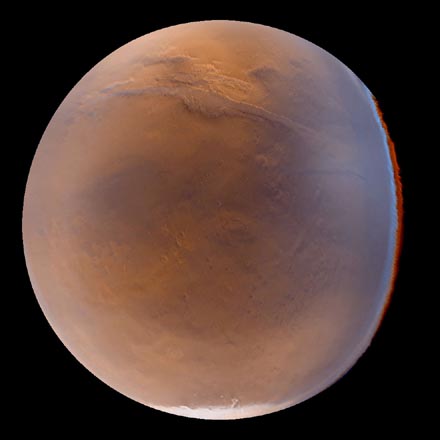| << Previous | Index | Next >> |
2015 Yesterday, the Sun exhibited one of the longest filaments ever recorded. It may still be there today. Visible as the dark streak just below the center in the featured image, the enormous filament extended across the face of the Sun a distance even longer than the Sun's radius -- over 700,000 kilometers. A filament is actually hot gas held aloft by the Sun's magnetic field, so that viewed from the side it would appear as a raised prominence. The featured image shows the filament in light emitted by hydrogen and therefore highlights the Sun's chromosphere. Sun-following telescopes including NASA's Solar Dynamics Observatory (SDO) are tracking this unusual feature, with SDO yesterday recording a spiraling magnetic field engulfing it. Since filaments typically last only from hours to days, parts of this one may collapse or erupt at any time, either returning hot plasma back to the Sun or expelling it into the Solar System. Is the filament still there? You can check by clicking on SDO's current solar image.
2014
Click to play embedded YouTube video.
Video Credit & Copyright: Red Bull Stratos, GoPro;
Music: Wilderness is Their Home Now & Satellites (East of the River), ExtremeMusic
Music: Wilderness is Their Home Now & Satellites (East of the River), ExtremeMusic
2013 Rocks from space hit Earth every day. The larger the rock, though, the less often Earth is struck. Many kilograms of space dust pitter to Earth daily. Larger bits appear initially as a bright meteor. Baseball-sized rocks and ice-balls streak through our atmosphere daily, most evaporating quickly to nothing. Significant threats do exist for rocks near 100 meters in diameter, which strike the Earth roughly every 1000 years. An object this size could cause significant tsunamis were it to strike an ocean, potentially devastating even distant shores. A collision with a massive asteroid, over 1 km across, is more rare, occurring typically millions of years apart, but could have truly global consequences. Many asteroids remain undiscovered. In fact, one was discovered in 1998 as the long blue streak in the above archival image taken by the Hubble Space Telescope. Further, just last year the 50-meter wide asteroid 2012 DA14 was discovered that will pass inside the orbit of Earth's geosynchronous satellites this coming Friday. A collision with a large asteroid would not affect Earth's orbit so much as raise dust that would affect Earth's climate. One likely result is a global extinction of many species of life, possibly dwarfing the ongoing extinction occurring now.
2012 This sharp Hubble Space Telescope view looks deep into NGC 6752. Some 13,000 light-years away toward the southern constellation Pavo, the globular star cluster roams the halo of our Milky Way galaxy. Over 10 billion years old, NGC 6752 holds over 100 thousand stars in a sphere about 100 light-years in diameter, but the Hubble image frame spans the central 10 or so light-years and resolves stars near the dense cluster core. In fact the frame includes some of the cluster's blue straggler stars, stars which appear to be too young and massive to exist in a cluster whose stars are all expected to be at least twice as old as the Sun. Explorations of the NGC 6752 have also indicated that a remarkable fraction of the stars near the cluster's core, are multiple star systems, supporting arguments that star mergers and collisions in the dense stellar environment can create the cluster's blue straggler stars.
2011 Hanny's Voorwerp, Dutch for "Hanny's Object", is enormous, about the size of our own Milky Way Galaxy. Glowing strongly in the greenish light produced by ionized oxygen atoms, the mysterious voorwerp is below spiral galaxy IC 2497 in this view from the Hubble Space Telescope. Both lie at a distance of some 650 million light-years in the faint constellation Leo Minor. In fact, the enormous green cloud is now suspected to be part of a tidal tail of material illuminated by a quasar inhabiting the center of IC 2497. Powered by a massive black hole, the quasar suddenly turned off, leaving only galaxy and glowing voorwerp visible in telescopes at optical wavelengths. The sharp Hubble image also resolves a star forming region in the voorwerp, seen in yellow on the side near IC 2497. That region was likely compressed by an outflow of gas driven from the galaxy's core. The remarkable mystery object was discovered by Dutch schoolteacher Hanny van Arkel in 2007 while participating online in the Galaxy Zoo project. Galaxy Zoo enlists the public to help classify galaxies found in the Sloan Digital Sky Survey, and more recently in deep Hubble imagery.
2010 Why does a volcanic eruption sometimes create lightning? Pictured above, the Sakurajima volcano in southern Japan was caught erupting early last month. Magma bubbles so hot they glow shoot away as liquid rock bursts through the Earth's surface from below. The above image is particularly notable, however, for the lightning bolts caught near the volcano's summit. Why lightning occurs even in common thunderstorms remains a topic of research, and the cause of volcanic lightning is even less clear. Surely, lightning bolts help quench areas of opposite but separated electric charges. One hypothesis holds that catapulting magma bubbles or volcanic ash are themselves electrically charged, and by their motion create these separated areas. Other volcanic lightning episodes may be facilitated by charge-inducing collisions in volcanic dust. Lightning is usually occurring somewhere on Earth, typically over 40 times each second.
2009 Alnitak, Alnilam, and Mintaka, are the bright bluish stars from east to west (left to right) along the diagonal in this gorgeous cosmic vista. Otherwise known as the Belt of Orion, these three blue supergiant stars are hotter and much more massive than the Sun. They lie about 1,500 light-years away, born of Orion's well-studied interstellar clouds. In fact, clouds of gas and dust adrift in this region have intriguing and some surprisingly familiar shapes, including the dark Horsehead Nebula and Flame Nebula near Alnitak at the lower left. The famous Orion Nebula itself lies off the bottom of this star field that covers about 4.5x3.5 degrees on the sky. This image was taken last month with a digital camera attached to a small telescope in Switzerland, and better matches human color perception than a more detailed composite taken over 15 years ago.
2008 Gravity can bend light, allowing huge clusters of galaxies to act as telescopes. Almost all of the bright objects in this Hubble Space Telescope image are galaxies in the cluster known as Abell 2218. The cluster is so massive and so compact that its gravity bends and focuses the light from galaxies that lie behind it. As a result, multiple images of these background galaxies are distorted into long faint arcs -- a simple lensing effect analogous to viewing distant street lamps through a glass of wine. The cluster of galaxies Abell 2218 is itself about three billion light-years away in the northern constellation of the Dragon (Draco). The power of this massive cluster telescope has allowed astronomers to detect a galaxy at redshift 5.58, the most distant galaxy yet measured. This young, still-maturing galaxy is faintly visible to the lower right of the cluster core.
2007 The center of our Milky Way Galaxy is hidden from the prying eyes of optical telescopes by clouds of obscuring dust and gas. But in this stunning vista, the Spitzer Space Telescope's infrared cameras, penetrate much of the dust revealing the stars of the crowded galactic center region. A mosaic of many smaller snapshots, the detailed, false-color image shows older, cool stars in bluish hues. Reddish glowing dust clouds are associated with young, hot stars in stellar nurseries. The galactic center lies some 26,000 light-years away, toward the constellation Sagittarius. At that distance, this picture spans about 900 light-years.
2006 This beautiful cosmic cloud is a popular stop on telescopic tours of the constellation Sagittarius. Eighteenth century cosmic tourist Charles Messier cataloged the bright nebula as M8, while modern day astronomers recognize the Lagoon Nebula as an active stellar nursery about 5,000 light-years distant, in the direction of the center of our Milky Way Galaxy. Striking details can be traced through this remarkable picture, processed to reveal the Lagoon's range of filaments of glowing hydrogen gas and dark dust clouds along with the brighter, turbulent hourglass region at the upper right. The view is a color composite of narrow and broad band images recorded under dark skies in northwestern Arizona. At the Lagoon's estimated distance, the picture spans about 30 light-years.
2005 This strange, false-color image of otherwise familiar planet Saturn shows temperature changes based on thermal infrared emission in the gas giant's atmosphere and rings. Recorded from the Keck I telescope on Mauna Kea, the sharp, ground-based picture of Saturn's southern hemisphere is a mosaic of 35 images. Based on the effects of sunlight during the southern summer season, general warming trends were anticipated. But a surprising result of the infrared image data is the a clear indication of an abruptly warmer polar cap and bright hot spot at Saturn's south pole. The warm south pole and hot spot may be unique in the solar system and a further exploration of the region is planned using instruments on the Cassini spacecraft. So how hot is Saturn's hot spot? The upper tropospheric temperature is a sweltering 91 Kelvin (-296 degrees Fahrenheit) at the pole.
2004 What are those unusual spherules on Mars? The Mars Opportunity rover has now photographed several unusual nodules on Mars that have a nearly spherical shape. Many times these spherules are embedded in larger rock outcroppings but appear grayer. Pictured in the inset is one such spherule embedded in a rock dubbed Stone Mountain, visible to the Opportunity rover now rolling inside a small crater on Meridiani Planum. Opportunity was directed to go right up to Stone Mountain to get a better look. The inset picture spans only 3 centimeters across, revealing the rock to be named more for shape than actual size. Scientists are currently debating the origin of the spherules. One leading hypothesis holds that the beads were once-molten rock that froze in mid-air after an impact or a volcanic eruption. Another hypothesis holds that the spherules are concretions, hard rock that slowly accumulates around a central core. Opportunity will work to solve this mystery and others over the next few days.
2003 A comet may likely become visible to the unaided eye over the next few days above the horizon where the Sun has just set. Comet NEAT (C/ 2002 V1), discovered last November, has brightened dramatically as it approached the Sun. Over the next few days, the quickly setting comet could appear as bright as second magnitude. On February 18 it will round the Sun well within the orbit of Mercury. During surrounding days, the Sun's glare will effectively hide the comet to human observers. It is quite probable, though, that Comet NEAT will standout prominently in images taken by the Sun-looking SOHO satellite. Pictured above, Comet NEAT's complex and developing tail was photographed on January 29 (top) and February 2. Sky enthusiasts should remember to never look directly at the Sun.
2002 The stars are not alone. In the disk of our Milky Way Galaxy about 10 percent of visible matter is in the form of gas, called the interstellar medium (ISM). The ISM is not uniform, and shows patchiness even near our Sun. It can be quite difficult to detect the local ISM because it is so tenuous and emits so little light. This mostly hydrogen gas, however, absorbs some very specific colors that can be detected in the light of the nearest stars. A working map of the local ISM within 10 light-years based on recent observations is shown above. These observations show that our Sun is moving through a Local Interstellar Cloud as this cloud flows outwards from the Scorpius-Centaurus Association star forming region. Our Sun may exit the Local Interstellar Cloud during the next 10,000 years. Much remains unknown about the local ISM, including details of its distribution, its origin, and how it affects the Sun and the Earth.
2001 Sailing upside down, 115 nautical miles above Earth, the crew of the Space Shuttle Endeavour made this spectacular time exposure of the southern aurora (aurora australis) in October of 1994. Aurora, also known as the northern and southern lights, appear as luminous bands or streamers of light which can extend to altitudes of 200 miles. They are typically visible from the Earth's surface at high latitudes and are triggered by high energy particles from the Sun. The delicate colors are caused by energetic electrons colliding with oxygen and nitrogen molecules in the upper atmosphere. In this picture, the rear structure of the shuttle Endeavour is in the foreground with the vertical tail fin pointed toward Earth. Star trails are the short streaks above Earth's horizon.
2000 After an unanticipated extra trip around the Sun, the NEAR spacecraft is now politely approaching asteroid 433, Eros, at a respectful relative speed of about 20 miles per hour. Still nearly 2,000 miles distant, NEAR will close to within approximately 200 miles by February 14th - Valentine's Day. If all goes well, the spacecraft will then be captured by the gentle attraction of Eros' gravity, becoming the first artificial moon of an asteroid. While Eros is not round it is certainly not heart-shaped either as seen in this series of frames showing the roughly 20 x 8 x 8 mile asteroid during its 5.27 hour rotation period. Different perspectives clearly show a gouge or saddle and a large impact crater with a raised rim near the asteroid's narrow waist. The frames were recorded by the NEAR spacecraft's multi-spectral imager on February 4th from a range of 4,600 miles.
1999 Do the powerful explosions known as gamma-ray bursts (GRBs) originate in galaxies? This subject took on new light yesterday with the release of a Hubble Space Telescope image of the sky surrounding GRB 990123. This burst was first detected only two weeks ago and cataloged as one of the most powerful GRBs ever. The optical transient (OT) counterpart to the GRB can be seen as the bright spot just below center. Once so bright it was briefly visible with just binoculars, this OT has since become four million times dimmer and continues to fade. Now, it can be seen easily with only a large telescope. The diffuse object above is of particular interest because it appears to be the host galaxy of GRB 990123. This distant galaxy seems to have a normal brightness but an irregular shape. This discovery increases the evidence that most OTs do occur in galaxies. Are all host galaxies this strange?
1998 Mars Global Surveyor is photographing Mars. The robot spacecraft arrived last September and continues to use solar panel aerobraking to help maneuver it to a better orbit to survey all of Mars The above image is a reconstruction of several photographs digitally combined to simulate a single vantage point 2700 kilometers above the Martian surface. The images were taken by the Mars Orbital Camera in wide angle mode in late December 1997. Visible features include the Valles Marineris canyon across the top, and the South Polar Cap of frozen carbon dioxide at the bottom. Many finer features that would normally be visible are hidden by dust remaining from a planet-wide storm that subsided only three weeks before these images were recorded.
1997 What if you could see gamma rays (photons with more than 40 million times the energy of visible light)? If you could, the Moon would appear brighter than the Sun! This startling notion is demonstrated by this image of the Moon from the Energetic Gamma Ray Experiment Telescope (EGRET) onboard NASA's orbiting Compton Gamma Ray Observatory. The most sensitive instrument of its kind, even EGRET can not see the quiet Sun which is faint at extreme gamma-ray energies. Why is the Moon so bright in gamma rays? High energy charged particles known as cosmic rays, constantly bombard the unprotected lunar surface generating gamma rays. EGRET's gamma-ray vision is not sharp enough to resolve a lunar disk or any surface features but its sensitivity reveals the bright gamma-ray moonglow against a background of gamma rays from our Milky Way galaxy, gamma-ray quasars and some still mysterious unidentified sources. The image was generated from eight exposures made during 1991-1994. A wide-angle picture, it covers a roughly 40x40 degree field of view with gamma-ray intensity represented in false color.
1996 The first US spacecraft was Explorer 1. The cylindrical 30 pound satellite was launched (above) as the fourth stage of a Jupiter-C rocket (a modified US Army Redstone ballistic missile) and achieved orbit on January 31, 1958. Explorer I carried instrumentation to measure internal and external temperatures, micrometeorite impacts, and an experiment designed by James A. Van Allen to measure the density of electrons and ions in space. The measurements made by Van Allen's experiment led to an unexpected and startling discovery - an earth-encircling belt of high energy electrons and ions trapped in the magnetosphere - now known as the Van Allen Belt. Explorer I ceased transmitting on February 28 of that year but remained in orbit until March of 1970.
| << Previous | Index | Next >> |

